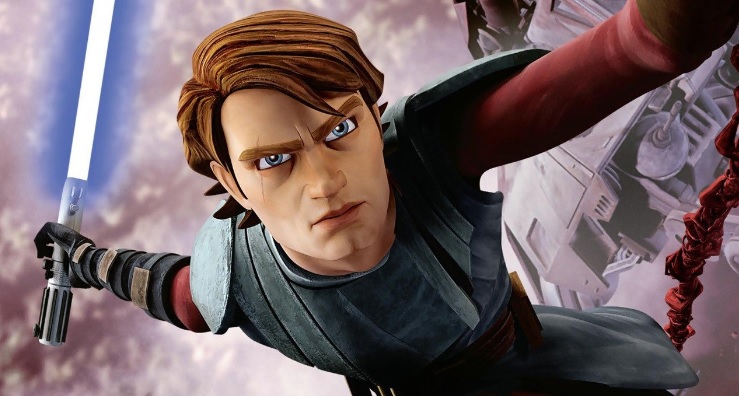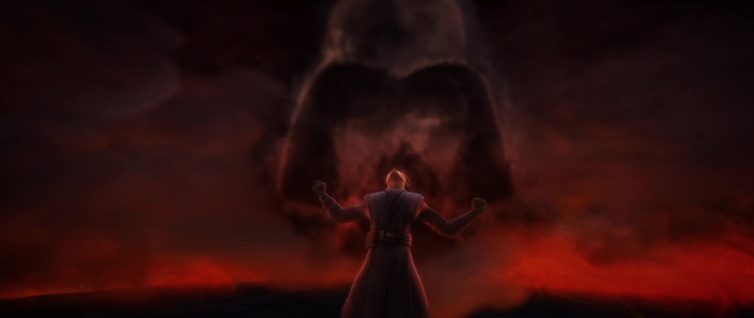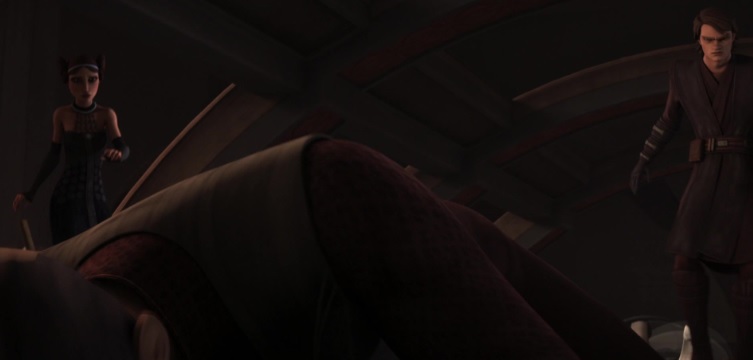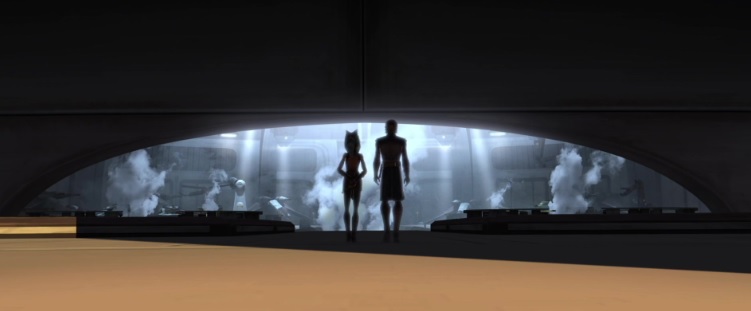
The Clone Wars is BACK. The most surprising Star Wars announcement of recent times has led to an outpouring of love for a series that remains an essential part of our understanding of George Lucas’s universe. Lucas told many more hours of stories in TCW than on the big screen, and one thing that extra time and space allowed him to do was fill in and refine his vision of Anakin Skywalker.
In Attack of the Clones, Lucas arguably showed his hand too soon. With the audience aware of Anakin’s fate, the shadow of Vader looms large, both in Anakin’s “joke” about dictatorships (run, Padmé!) and his heinous slaughter of the Tusken Raiders (RUN, PADMÉ!). The petulant teenage edge and creepy behaviour makes him hard to like, and there is a sense of something fundamentally “dark side” about him that everyone around him is crazy not to see. In Revenge of the Sith, we meet a different Anakin: for the first hour he is heroic, likeable and sympathetic, haunted by the fear of his wife’s death, a pawn in a political game between Palpatine and the Jedi Council. His fall seems to come from a place of good – albeit confused – intentions. Yet it happens extremely quickly. How could he go from “what have I done?” to slaughtering younglings in a matter of moments?
It is the “heroic” Anakin that TCW picks up and runs with. Dave Filoni revealed at Comic Con that his priority in casting Anakin was, above all, “likeability” – the charismatic Republic hero Filoni imagined as a child. TCW Anakin has a square jaw, a noble voice, and is in all respects the swashbuckling hero and hotshot pilot the original trilogy led us to believe he was. We are on Anakin’s side immediately, he’s a hero we can root for – a bit Luke, a bit Han, a bit Poe. From there, TCW adds flesh to the bones of his fall, rooting it not in a fundamental darkness – but in the very things that make him a hero.
The Age of Heroes
The idea of the hero who is too “heroic” is found throughout myth, legend and literature. One Knight who fits the bill is Sir Lancelot, the golden boy of King Arthur’s court – handsome, daring, the greatest swordsman and jouster of his age, he is the quintessential chivalric hero. Yet his passions consume him: his affair with Guinevere brings down the court – like Anakin’s for Padmé, it is a forbidden love that destroys everything. A more modern example – one Filoni would have been very familiar with – is Boromir in The Lord of the Rings, the noble hero who seeks only to protect his people, but in his desire to defeat the evil of Mordor reaches out to claim the Ring of Power for himself, and falls into darkness.
Like Boromir, the Anakin of TCW wants to be the hero, to get out there and protect his Republic. He builds strong relationships with Admiral Yularen and with his clones, defies the restrictive and frustrating orders of the Council and teaches his Padawan Ahsoka to do the same. As the war continues, he sees things in increasingly absolute terms, explaining the political context of the war to Ahsoka in “Heroes on Both Sides” as: “The Separatists believe the Republic is corrupt, but they’re wrong, and we have to restore order.”
This most complicated Star Wars conflict becomes, to Anakin, a simple case of good vs evil, and he will defeat the evil of chaos and disorder by any means necessary. When he meets Tarkin in the Citadel arc, he and the future Grand Moff share an admiration for the architecture of the terrifying prison, and agree that the Jedi Code is an obstacle which prevents the Jedi from doing what it takes to win the war. Where Obi-Wan sees the war as a moral compromise and fears the corruption of the Jedi, to Anakin the Code itself is the compromise, its restrictions on aggressive and violent actions a constant frustration. To Anakin, the ends – peace, security, prosperity – always justify the means, and his natural inclination towards action and heroism make him an easy fit with the military. “I wish more Jedi had your military sensibilities,” Tarkin compliments him.
The series is littered with Jedi who fall. The war itself, as revealed in the Mortis arc, is pushing the Force out of balance, spreading fear and hatred across the galaxy and helping the dark side to rise. Pong Krell surrenders to the inevitability of darkness and prioritizes his own place in the new order, while Barriss Offee sees violent protest as the only way to end Jedi involvement in the war – in doing so becoming the very thing she is protesting against. The line between good and evil is thin and easily crossed, particularly in wartime.
TCW also gives us something notably absent from the prequels – Anakin’s “dark side cave” trial. Luke and Rey must confront unsettling visions in the middle acts of their trilogies, revealing dark fears they would rather repress, and Anakin faces the same on Mortis. To some extent the entire arc is a “Dagobah cave” – the Force is amplified and personified in the allegorical characters of the Father, the Son and the Daughter, who take on roles in the Star Wars version of a medieval morality play.

On Mortis, Anakin is our Everyman, tested and tempted as he faces the Force’s judgement and discovers the truth of himself. On his journey, he enters the volcanic pit of the dark side and sees the destruction he will cause. In order to stop it, he agrees to join the dark side when the Son promises that together they can destroy both Sith and Jedi, and in doing so “bring peace.” Fear of the future and the quest for peace are the very things that will cause the real fall he is trying to prevent. His failure on Mortis is a fall within a fall.
Severing Mace Windu’s hand and saving Palpatine in RotS is an instinctive act Anakin cannot turn back from, because turning on Palpatine would destroy the only hope of Padmé’s survival. What TCW does is explain how he is then able to justify his later actions to himself. Anakin craves peace and order, and if a few Jedi younglings must die, younglings who would one day grow up to start a Rebellion…well, that tragedy is nothing compared to endless civil war and the death of billions. Anakin is lying to himself, but it is a lie he is desperate to believe. The authoritarianism and tyranny of Darth Vader is merely the flip-side of the heroism of Anakin Skywalker.
The Art of Letting Go
The other aspect of Anakin’s fall – his issues with attachment – is also explored more thoroughly in TCW, in that we see his relationships on more of an “average day” level than the extreme events of AotC and RotS. The reason Ahsoka is placed with him as Padawan is as much a part of his training as hers: “Ready, he is, to teach an apprentice,” Yoda tells Obi-Wan. “To let go of his pupil, a greater challenge it will be.” Yoda recognized Anakin’s fear of loss when they first met in the Temple in TPM, and sees that Skywalker still struggles with it.
Early in TCW, Anakin is overprotective of Ahsoka, and the two are regularly contrasted with more traditional Jedi, who by comparison can seem distant and less exciting. In the Geonosis arc, they work alongside Luminara Unduli, a Master who trusts her apprentice Barriss to stand on her own two feet. Anakin’s unwillingness to let Ahsoka put herself in danger is reinforced when he tries to prevent her from joining the Citadel mission, but progresses in the following story, “Padawan Lost” and “Wookiee Hunt”. Ahsoka is captured by Trandoshan hunters, and Anakin’s instinct is to leap into action and scour the galaxy for her, struggling to accept that a loved one’s fate is out of his power. He is, after all, Anakin Skywalker – he should be able to protect everyone.
Plo Koon, as Luminara did, advises Anakin to let go and trust in Ahsoka, and she rises to the occasion, becoming a leader, a teacher and a beacon of hope for the other captured Padawans – everything a Jedi should be. Anakin’s joy at her return, and understanding that his teachings have enabled her to survive, are tempered by guilt, but it is nevertheless a step forward. Part of a healthy relationship is seeing the other as an independent person, whose identity is not chained to yours and whose choices are their own. Unfortunately, Anakin’s progress comes to a halt in the season five finale, when Ahsoka is framed for murder and dismissed from the Order. In “Crystal Crisis on Utapau”, Anakin does not solely blame the council for this – he also resents Ahsoka, her independence and her choice to follow a path that is not tied to his.
This echoes the complicated and somewhat unhealthy relationship Anakin has with Padmé. Building on his line in RotS, “you’re sounding like a Separatist”, TCW Anakin gets angry when Padmé expresses a political opinion that is inconvenient to his worldview. He dislikes it when she takes missions on her own and is steadfastly opposed to her attempts to teach Ahsoka a more nuanced view of the war in “Heroes on Both Sides”. This lack of trust is the very thing that will cause him to Force-choke Padmé on Mustafar, when he leaps to the conclusion that she has betrayed him to Obi-Wan.
Anakin’s jealousy is also explored via Rush Clovis, Padmé’s old flame and, on the surface, a bit of a sleazeball. Anakin’s behavior is childish, petulant and eventually violent, and proves Yoda’s words in RotS: “attachment leads to jealousy.” This is jealousy in its true sense – not envy, but the fear that something you possess will be taken from you. Anakin’s love for Padmé, as he reveals in “Hostage Crisis”, is selfish: “Nothing is more important than the way I feel about you.” It is not Padmé he loves, it is the way Padmé makes him feel, the comfort she brings him.

On Mortis, Anakin sees a vision of his mother and confesses (with wonderful prequel verbosity) “the only love I feel is haunted by what would happen should I let go.” “Then it is not love”, Shmi replies. “It is a prison.” This is a tragic insight: Anakin is unable to find lasting joy in the presence of his loved ones, because he lives in constant fear that they will be taken from him. This struggle, and how easily a selfless love can be polluted by selfish possessiveness, gives us a more nuanced and “grounded” look at his relationships than the heightened mythic story of the films.
One Last Lesson
The brilliance of Anakin’s portrayal in TCW is that both issues – his desire to control the lives of his loved ones and to control the fate of the galaxy – are inextricably linked as the single “fatal flaw” that every good tragic hero possesses: his inability to let go and accept that he can’t control everything, and that change, however difficult, is a natural part of life. To cling on and attempt to control only causes more suffering for ourselves and for those we believe we are protecting. This flaw is sympathetic because it is the flip-side of Anakin’s heroism – and in much of Western culture, a passionate desire to save others, especially loved ones, would be seen as heroic. Star Wars takes a different view: “the most beautiful form of mastery”, to quote Claudia Gray’s short story “Master and Apprentice”, “is the art of letting go.”
On the commentary to A New Hope, Lucas says that Luke is “the compassionate hero” while Han is “the passionate hero.” Anakin in TCW is undoubtedly the latter. While Han’s arc is defined by his development from passionate to compassionate, Anakin falls to his passions. Even the idealistic Luke must learn to let go, surrender to the Force and throw away his weapon; while in The Last Jedi, Poe learns that by fighting aggressively and trying to be the hero, you risk losing everything you think you are protecting. Anakin in TCW is the definition of that message.
Credit must be given to Lucas for using TCW to build on his movies and give new depth to Anakin, and make his flaws more sympathetic. Matt Lanter’s Anakin does not supplant Hayden Christensen’s but compliments it, giving us more insight into why he does what he does. With the series returning and the near-certainty that we will see the Siege of Mandalore, taking us right up to the events of RotS, we will finally see the final piece of the puzzle in Lucas’s story, and nothing in Star Wars storytelling is more exciting than that.


Yes, a large part of Anakin’s fall is problematic in the films because of pacing issues. The Clone Wars let us see how Obi-Wan Kenobi could view him as a good friend while not ignoring the flaws that are built into his personality.